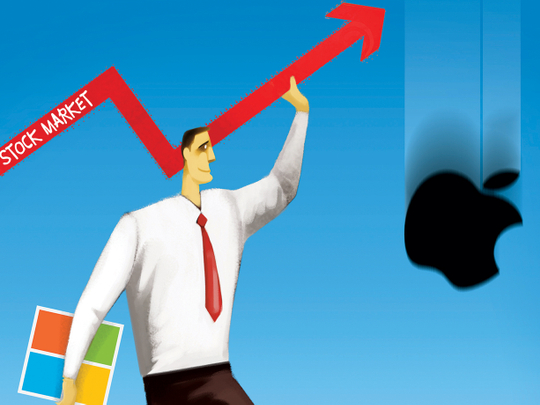
It isn’t every week that two vast tech companies such as Facebook and Microsoft see a combined $53 billion added to their stock market valuation — particularly when it coincides with a slide that wipes $73bn off the joint valuation of two others, Apple and Amazon.
Yet that is what happened, as Wall Street tried to digest an unusually volatile earnings season in the technology sector. Such large valuation swings in tech often point to shifting tectonic plates in the industry, as investors move money out of maturing technology markets and into newer ones with bigger growth potential.
The violent stock price swings of big tech showed some of those forces at work, with Wall Street warming to signs that promising new markets including mobile advertising and cloud computing were starting to boom. But they also reflected shorter-term successes or disappointments, as a set of companies that are each among the 10 largest in the US by stock market value have in some cases struggled to live up to expectations.
As so often during earnings season, it was internet retailer Amazon that provided the biggest whiplash for tech investors. The market sent Amazon’s share price up 9 per cent on January 28 in anticipation of strong results, but the stock plunged 13 per cent in aftermarket trading when profits came in 35 per cent below Wall Street’s expectations.
Amazon conceded that during its busiest quarter it had misjudged the demand from third-party sellers who store items in Amazon warehouses and pay the retailer to handle shipping logistics. “This did make our warehouses rather full and caused us to incur some variable costs in the US,” said Brian Olsavsky, Amazon’s chief financial officer. Fulfilment expense rose by a third in the fourth quarter, contributing to the lower-than-expected profits.
However, analysts also blamed Amazon’s historic disregard for profits as part of the reason for Wall Street’s disappointment. “This is not a management team that listens to the Street all that much, or frankly cares about what the Street thinks all that much,” said Youssef Squali, analyst at Cantor Fitzgerald.
Amazon’s heavy investment levels have historically left little room for profit. The company has reported less than $600 million in cumulative profits over the past four years, even while revenues have surged. It has been investing heavily in new areas such as producing films for Amazon Video, building new data centres, expanding retail operations in India, and growing its logistics operations in the US.
The net effect was that, even though Amazon’s profit margins rose in the latest quarter, big increases in headcount and in investments limited the increase and worried investors.
Yet if Amazon’s higher spending caused unease, its latest earnings also confirmed that the company’s cloud computing arm, Amazon Web Services, remains a bright spot. As the fastest-growing and highest-margin part of the company, hopes for AWS had underpinned a 62 per cent bounce in the company’s shares since last April — at least, until January 28’s earnings disappointment. Revenues from AWS grew 69 per cent in the fourth quarter, reaching $2.4 billion.
Even faster growth in Microsoft’s cloud computing business added to growing Wall Street confidence that new chief executive Satya Nadella has found a formula that will carry the company beyond the PC era. Azure — its cloud computing platform that competes with AWS — reported a 140 per cent jump in revenues, an acceleration from the preceding quarter.
In case investors had missed the point, Nadella was on hand to stress the sheer size of the opportunity ahead: “The enterprise cloud market is massive, much bigger than any other market we’ve been in.”
Microsoft’s latest numbers also helped to dispel some of the concerns that a shift from software to cloud revenues would weaken the company’s profit margins.
Margins in its cloud business had started to rise, according to chief financial officer Amy Hood, as Microsoft benefited from lower unit costs and succeeded in moving customers to higher-value services.
The news was enough to add more than 4 per cent to Microsoft’s shares, even though its much larger PC business declined further in the latest quarter and its overall revenues and profits fell.
The fresh insight into cloud computing from the Amazon and Microsoft earnings came in a week that also shone a spotlight on the another seismic technology shift: the rise of mobile.
Apple investors were rattled as the company faced up to the likelihood that iPhone sales would fall for the first time as there were fewer new buyers to tap. But the same forces had the opposite effect on Facebook: thanks to the huge base of existing smartphone owners and their increasing use of Facebook services, advertisers are now redirecting much larger proportions of their budgets to mobile, supercharging the social networking company’s growth.
The likely shift of value from hardware to services in a maturing smartphone market was neatly illustrated by Wall Street’s reaction: Apple’s stock market value fell $36 billion in a single day, while Facebook’s gained $36 billion.
Apple also tried to ride this new mobile services bandwagon, arguing that, with 1 billion of its devices now in use, it was well positioned to share in the rewards. But the attempt to start recasting itself as a post-hardware company fell flat, setting the tone for what could be a difficult year.
Financial Times












